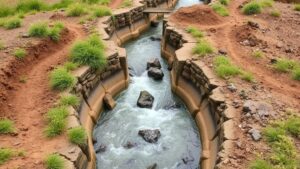The Role of Shear Zone Structures in Hosting Gold and Silver Ore Bodies
The Role of Shear Zone Structures in Hosting Gold and Silver Ore Bodies
Shear zone structures play a crucial role in the formation and localization of gold and silver ore bodies. These geological features can significantly influence mineralization processes and the concentration of precious metals. Understanding the dynamics of shear zones is essential for geologists and mining companies aiming to uncover economically viable deposits.
Understanding Shear Zones
Shear zones are regions of intense deformation within the Earths crust, typically characterized by the significant movement of rocks along fault lines. As tectonic forces act upon the crust, these zones manifest as fractures and faults that can extend over considerable distances. Importantly, shear zones can create pathways for mineralizing fluids, which are critical in the process of ore body formation.
Formation Processes of Shear Zones
The formation of shear zones usually occurs in response to prolonged tectonic stress, resulting in deformation including folding, faulting, and fracturing. This process operates under high pressure and temperature conditions, often leading to the metamorphosis of surrounding rock. In many cases, these shear zones become conduits for hydrothermal fluids that carry dissolved metals.
- Shear zones can form in both compressional and extensional tectonic settings, highlighting their versatility in various geological environments.
- Understanding the specific conditions that create these zones aids geologists in predicting locations where valuable ore bodies may form.
Mechanisms of Mineralization
Mineralization typically occurs when hydrothermal fluids migrate through shear zones and deposit precipitated minerals, driven by changes in pressure, temperature, or chemical composition. Gold and silver often precipitate out of solution when these fluids cool or react with surrounding rock. The following mechanisms are commonly involved in the process:
- Cooling of hydrothermal fluids: As fluids rise and lose heat, they lose their capacity to carry metals, leading to deposition.
- Chemical reactions: Interactions with host rocks may change the pH or oxidation state of hydrothermal fluids, causing the metals to precipitate.
Examples of Gold and Silver Deposits in Shear Zones
Numerous gold and silver deposits around the world are directly associated with shear zones, demonstrating the efficacy of these structures in hosting valuable ore bodies. Notable examples include:
- The Witwatersrand Basin, South Africa: This world-renowned gold-producing region is associated with multiple shear zones, where conglomerate-hosted gold occurs in discrete layers.
- The Red Lake Mine, Canada: Known for its high-grade gold deposits, Red Lake features a prominent shear zone that has been instrumental in the localization of ore bodies.
Geological Mapping and Exploration Strategies
Effective exploration for gold and silver typically involves detailed geological mapping aimed at identifying shear zones. Techniques such as geophysical surveys, geochemical analysis, and structural analysis allow geologists to delineate these features more accurately. Key strategies include:
- Remote Sensing: Satellite imaging and aerial LIDAR can help identify surface expressions of shear zones.
- Core Drilling: Drilling through identified shear zones provides direct insight into mineralization and structural integrity.
Challenges and Considerations
While shear zones present promising opportunities for gold and silver mineralization, they also pose challenges. complexity of these structures can lead to difficulties in estimating resource size and grade. Plus, the often-deep occurrence of these deposits necessitates advanced, cost-intensive exploration methods.
Conclusion
In summary, the role of shear zone structures in hosting gold and silver ore bodies is both significant and multifaceted. From their formation mechanisms to their impact on mineralization processes, understanding shear zones enables geologists to better strategize exploration efforts. As the global demand for gold and silver continues to rise, unlocking the potential of these geological features can lead to economically viable discoveries, contributing to the growth of the mining sector.
Actionable Takeaways
- For exploration companies, investing in advanced geological mapping and structural analysis can enhance the likelihood of successful mineral discoveries.
- Collaboration with geologists who specialize in tectonics and shear zones may yield insights that guide exploration practices more effectively.

